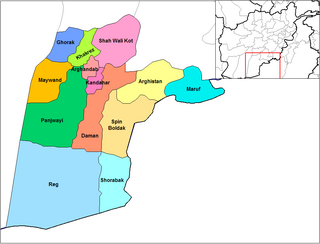
Arghandab is a district in the central part of Kandahar Province, Afghanistan. It borders Panjwai and Khakrez districts to the west, Shah Wali Kot District to the north and east and Kandahar District to the east and south.
Zhari is a district in Kandahar Province, Afghanistan. Alternative spellings include Zheley, Zharey, Zharay, Zheri, or Zheray. The district was created in 2004 from land that was formerly part of Maywand and Panjwai districts. The population is estimated at 80,700 (2010).

The Taliban insurgency began after the group's fall from power during the 2001 War in Afghanistan. The Taliban forces fought against the Afghan government, led by President Hamid Karzai, and later by President Ashraf Ghani, and against a US-led coalition of forces that has included all members of NATO; the 2021 Taliban offensive resulted in the collapse of the government of Ashraf Ghani. The private sector in Pakistan extends financial aid to the Taliban, contributing to their financial sustenance.
Operation Mountain Thrust was a joint NATO and Afghan-led military operation in the War in Afghanistan. It involved more than 3,300 British troops, 2,300 U.S. troops, 2,200 Canadian troops, along with approximately 3,500 Afghan soldiers, supported by extensive air power. Its primary objective was to quell the ongoing Taliban insurgency in the south of the country.

Operation Medusa was a Canadian-led offensive during the second Battle of Panjwaii of the War in Afghanistan. The operation was fought primarily by the 1st Battalion, The Royal Canadian Regiment Battle Group and other elements of the International Security Assistance Force, including A Co, 2-4 Infantry BN, 4th BDE, 10th Mtn Division, supported by the Afghan National Army and a team from the United States Army's 1st Battalion, 3rd Special Forces Group (Airborne) augmented by C Company, 2nd Battalion, 87th Infantry Regiment of the 10th Mountain Division. Its goal was to establish government control over an area of Kandahar Province centered in the district of Panjwayi some 30 kilometres (19 mi) west of Kandahar city. A tactical victory, it resulted in the deaths of 12 Canadian soldiers; five during the major combat operations, five in bombings, and two in a mortar/RPG attack during the reconstruction phase of the operation. Fourteen British military personnel were also killed when their plane crashed. Despite suffering a brutal battlefield defeat, the Taliban retained their presence in Kandahar province and did not lose their will to fight, leading to the subsequent Operation Falcon Summit. Nonetheless, Operation Medusa was at the time the most significant land battle ever undertaken by NATO.

Operation Mountain Fury was a NATO-led operation begun on September 16, 2006 as a follow-up operation to Operation Medusa, to clear Taliban insurgents from the eastern provinces of Afghanistan. Another focus of the operation was to enable reconstruction projects such as schools, health-care facilities, and courthouses to take place in the targeted provinces.

The following items form a partial timeline of the War in Afghanistan. For events prior to October 7, 2001, see 2001 in Afghanistan.
Events from the year 2007 in Afghanistan.

The Helmand province campaign was a series of military operations conducted by the International Security Assistance Force (ISAF) forces against Taliban insurgents and other local groups in the Helmand Province of Afghanistan. Their objective was to control a province that was known to be a Taliban stronghold, and a center of opium production. None of the ISAF's intended strategic and political objectives were achieved in the long term.
Kandahar Central Jail, also known as Sarpuza Prison or Sarposa Prison, is a minimum security prison in Kandahar, Afghanistan. It has been historically used for the incarceration of common criminals of Kandahar Province. In the last two decades, the facility has also been used to hold up Taliban and other insurgents. The name "Sarpuza" is a historical neighborhood in the city of Kandahar. As of 2017, the prison has approximately 1,900 inmates, and its warden is Col. Abdul Wali Hesarak.

The Battle of Arghandab began on June 18, 2008, when NATO-led forces attacked Taliban militants in response to Taliban attacks in Arghandab District and Kandahar. The battle in Arghandab marked the second time in less than a year that the Taliban has tried to take control of the area.

Mullah Naqib Alikozai, sometimes called Naqibullah, was an Afghan mujahideen commander and politician from the Kandahar area of southern Afghanistan. He was the leader of the Alikozai Pashtun tribe.
United States and NATO International Security Assistance Force (ISAF) operations, alongside Afghan National Army forces, continued against the Taliban through 2008.
Events from the year 2008 in Afghanistan.
Events from the year 2010 in Afghanistan.

Events from the year 2012 in Afghanistan.
The following lists events from 2014 in Afghanistan.

Taliban militants, wearing Afghan army uniform, stormed a prison outside the city of Ghazni on 14 September 2015, freeing more than 355 inmates. At least 148 of the escapees are considered to be a serious threat to national security. According to the Ministry of Interior, of those escape, 148 had been jailed for attacks on security forces, while 207 had been convicted for other crimes. Only three prisoners had been recaptured.
This article summarizes the history of the War in Afghanistan (2001–2021).
The 2006 Taliban offensive was a major military offensive launched by the Taliban in southern Afghanistan in the spring of 2006. The offensive was planned to unfold on three main fronts concentrated in the provinces of Helmand and Kandahar: the first front was to target northern Helmand, focusing on the districts of Sangin, Nowzad, and Kajaki. The second front aimed at southern Helmand, with a focus on the districts of Garmser and Nawa. The third, and most important, would be western Kandahar, targeting the districts of Maiwand, Zharey, and Panjwayi.










